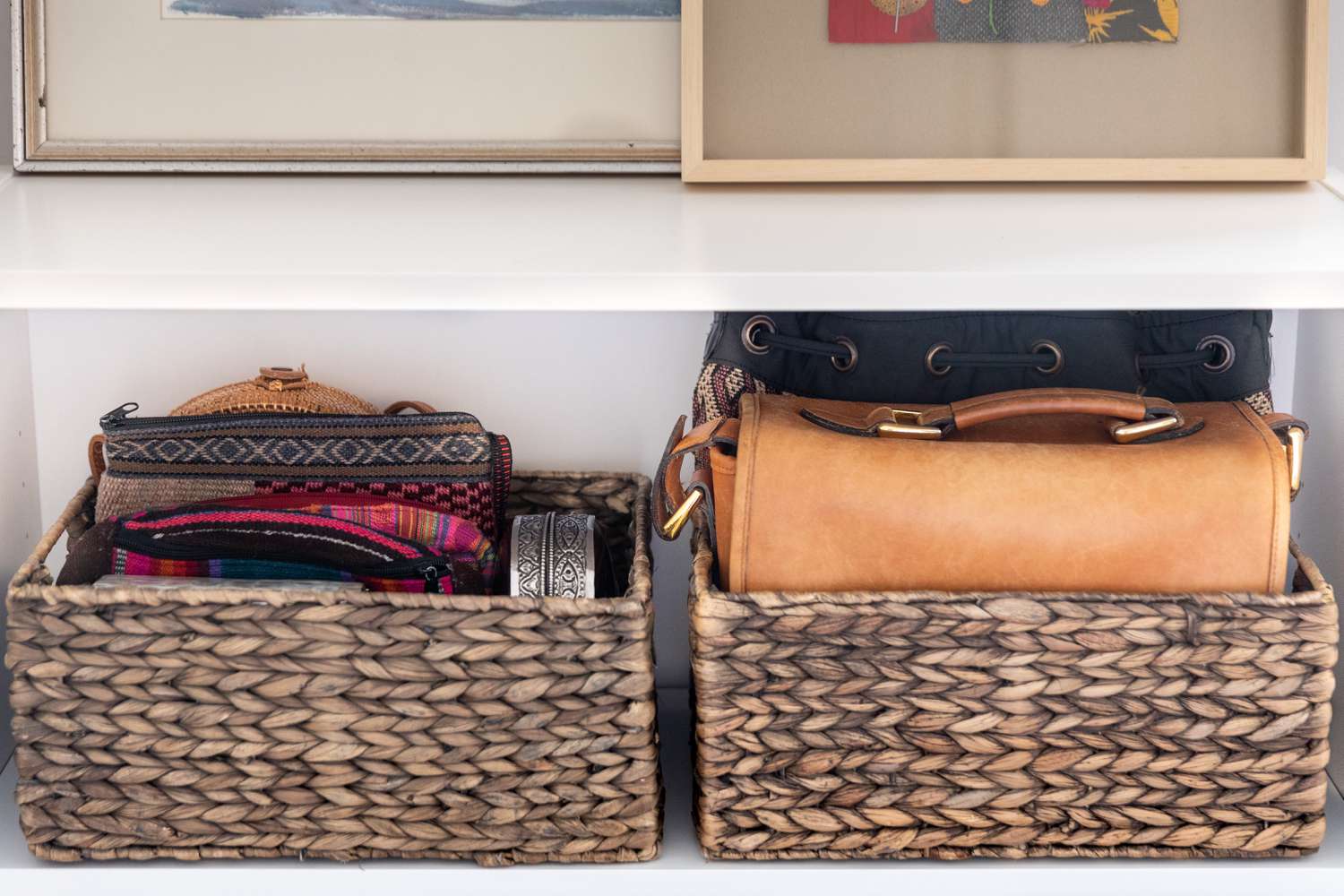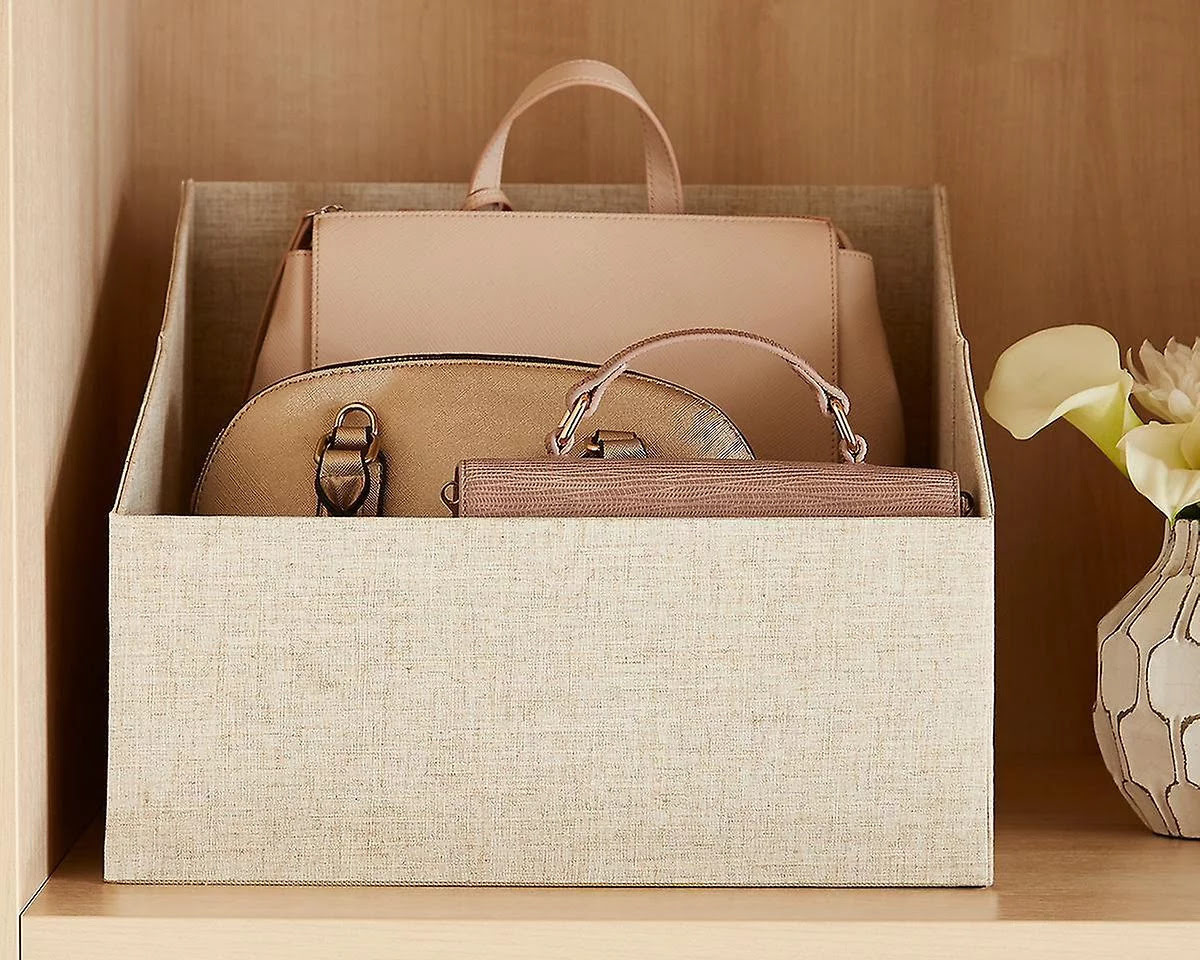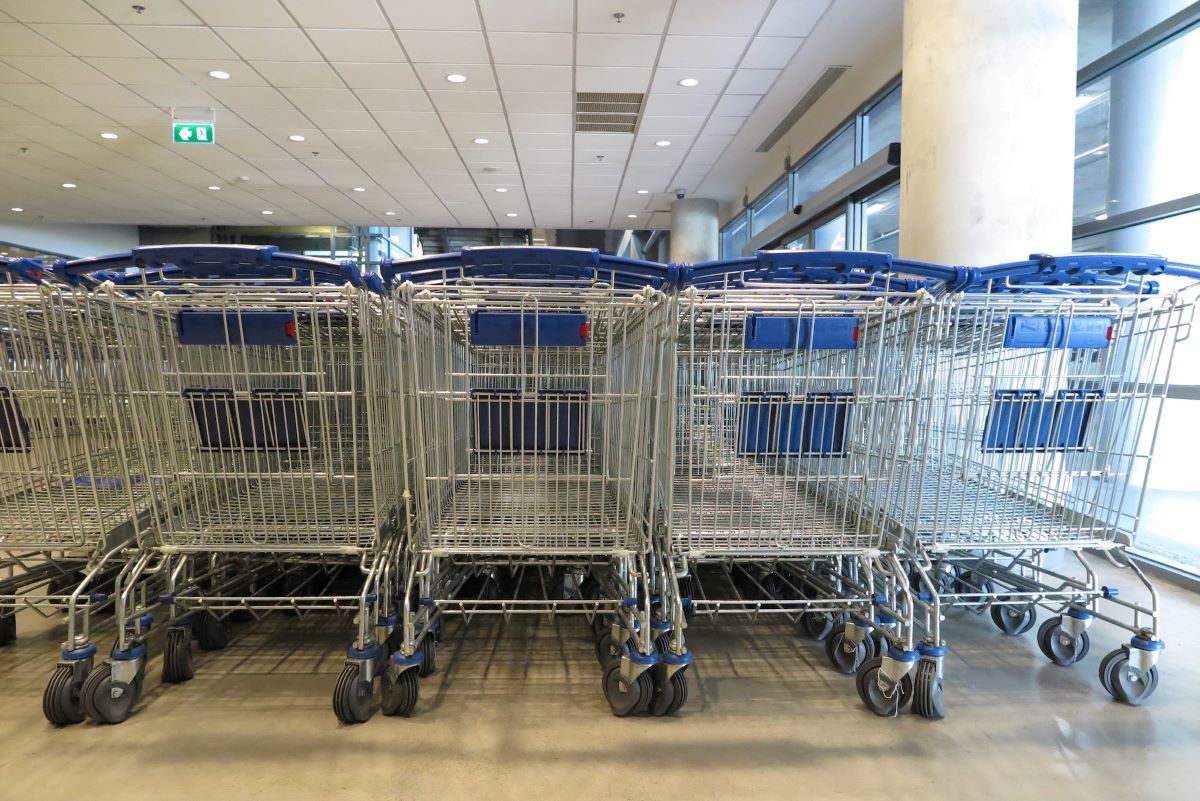

Articles
How To Store Handbags
Modified: March 3, 2024
Discover the best techniques for articles on how to store handbags and keep them in pristine condition. From organizing shelves to using protective covers, learn how to maximize space and preserve your favorite accessories
(Many of the links in this article redirect to a specific reviewed product. Your purchase of these products through affiliate links helps to generate commission for Storables.com, at no extra cost. Learn more)
Introduction
Handbags are not just a functional accessory; they often hold sentimental value and are cherished by their owners. Whether you have a small collection or a vast assortment of handbags, proper storage is essential to keep them in pristine condition and extend their lifespan. By implementing the right storage techniques, you can protect your handbags from damage, maintain their shape, and ensure easy accessibility whenever you need them.
In this article, we will delve into the world of handbag storage and provide you with valuable tips and insights on how to store your handbags properly. From selecting the right storage area to organizing and cleaning your handbag collection, we will cover everything you need to know to keep your handbags in top condition.
Stay tuned and discover the best practices for handbag storage that will help you preserve the beauty and integrity of your beloved accessories for years to come.
Key Takeaways:
- Proper handbag storage is crucial for maintaining the quality and longevity of your cherished accessories. By implementing the right storage techniques, you can protect your handbags from wear, tear, and damage caused by improper handling or storage conditions.
- Choosing the right storage area, preparing your handbags for storage, and protecting them from damage are essential steps in preserving the beauty and integrity of your handbag collection. By following best practices, you can ensure your handbags remain in excellent condition for years to come.
Read more: How To Store Designer Handbags
Understanding the Importance of Proper Handbag Storage
Proper handbag storage is crucial for maintaining the quality and longevity of your cherished accessories. By implementing the right storage techniques, you can protect your handbags from wear, tear, and damage caused by improper handling or storage conditions.
One of the main reasons why proper handbag storage is important is to preserve their shape. Handbags, especially those made from delicate materials like leather or suede, are prone to losing their shape when stored improperly. This can result in unsightly creases, wrinkles, or sagging, diminishing the overall aesthetic appeal of the bag. By storing your handbags in a way that supports their structure, you can maintain their original shape and keep them looking flawless.
Another key aspect of proper handbag storage is preventing damage caused by external factors like dust, sunlight, and moisture. Dust accumulation can dull the surface of your handbags and make them appear dull or unattractive. Excessive exposure to sunlight can fade the color of your bags or cause the materials to weaken and become brittle. Moisture, on the other hand, can lead to mold, mildew, or discoloration, ruining the appearance and integrity of your handbags. By storing your handbags in a clean, dry, and dark environment, you can safeguard them from these potential hazards.
Furthermore, proper storage techniques can also help you organize your handbag collection efficiently. By keeping your handbags neatly stored and easily accessible, you can save time and effort when searching for a specific bag. This also reduces the likelihood of accidentally damaging other bags while rummaging through a disorganized storage space.
Overall, investing in proper handbag storage methods is an investment in the longevity and beauty of your accessories. By following the guidelines and tips in this article, you can ensure that your handbags remain in excellent condition, age gracefully, and continue to be cherished items for years to come.
Choosing the Right Storage Area
When it comes to handbag storage, choosing the right storage area is crucial for protecting your beloved accessories. The ideal storage area should provide a clean and safe environment that minimizes exposure to dust, sunlight, and moisture. Here are some factors to consider when selecting a storage space:
1. Closet or Cabinet: A closet or cabinet can be an ideal storage area for your handbags. Make sure to choose a well-ventilated space that is away from direct sunlight and extreme temperature fluctuations. If possible, opt for a closet with adjustable shelves or dividers to accommodate bags of various sizes.
2. Shelf or Cubbies: Dedicated shelves or cubbies can provide a visually appealing and practical way to store your handbags. Ensure that the surface of the shelf or cubby is clean and smooth to prevent scratching or damaging the bags.
3. Dust Bags or Boxes: Dust bags or boxes are an excellent option for protecting your handbags from dust and potential damage. Look for dust bags made from breathable materials like cotton or linen to prevent moisture buildup. If using boxes, make sure they are clean, sturdy, and large enough to accommodate the bags without squishing them.
4. Hanging Storage: Hanging storage options, such as purse hangers or hooks, can be a space-saving solution for handbag storage. Just make sure that the hooks are strong enough to hold the weight of your bags and that they do not cause any strain or deformities on the handles or straps.
5. Display Cases: If you have a collection of designer or valuable handbags, consider investing in display cases. These cases not only provide protection but also allow you to showcase your bags as decorative pieces.
Remember, whatever storage area you choose, it is essential to keep it clean and free from clutter. Regularly dust and clean the storage space to prevent dust or dirt from settling on your handbags. By selecting the right storage area, you can ensure that your handbags are stored in a safe and organized manner, ready to be used whenever you need them.
Preparing Your Handbags for Storage
Before stashing your handbags away for an extended period, it’s crucial to properly prepare them to ensure they stay in pristine condition. Taking a few simple steps can go a long way in preserving the beauty and longevity of your handbags. Here are some tips for preparing your handbags for storage:
1. Clean Your Handbags: Thoroughly clean your handbags before storing them to remove any dirt, stains, or residues that may have accumulated. Use a gentle cleanser appropriate for the material of your bag, and follow the manufacturer’s instructions. Avoid using harsh chemicals or abrasive materials that could damage the bag’s surface.
2. Empty the Contents: Empty all the contents from your handbags, including any loose items, receipts, or personal belongings. This will help maintain the bag’s shape and prevent any potential damage caused by items shifting or pressing against the fabric.
3. Stuff the Bags: To maintain the shape of your handbags, stuff them with acid-free tissue paper, bubble wrap, or old t-shirts. Avoid using newspaper or colored tissue paper, as they may transfer ink or dyes onto the bag’s interior. Stuff the bags gently, avoiding overstuffing, to prevent any stress on the bag’s structure.
4. Protect Hardware and Accessories: If your handbag has metal hardware or delicate accessories, it’s important to protect them during storage. Use small pieces of tissue paper or soft cloth to cover and protect metal hardware, chains, or embellishments. This will prevent them from scratching or causing any damage to the bag’s exterior.
5. Consider Dust Bags: If your handbags came with dust bags, use them to provide an additional layer of protection against dust and light exposure. Dust bags can help preserve the bag’s quality and prevent any potential color fading or discoloration.
6. Avoid Extreme Temperatures and Humidity: When storing your handbags, choose a cool, dry, and well-ventilated area. Extreme temperatures and humidity can negatively impact the bag’s materials, causing them to warp, fade, or develop mold. Avoid storing handbags in spaces like attics, basements, or areas prone to temperature fluctuations or high humidity levels.
By following these simple steps, you can ensure that your handbags are well-prepared for storage. Properly cleaned and protected, they will be ready to retrieve and enjoy whenever you decide to showcase or use them again.
Cleaning and Organizing Your Handbag Collection
Keeping your handbag collection clean and well-organized is essential for not only maintaining their beauty but also ensuring easy accessibility. Regular cleaning and organizing routines will help extend the lifespan of your bags and make them a joy to use. Here are some tips for cleaning and organizing your handbag collection:
1. Regular Maintenance: Make it a habit to do regular maintenance on your handbags. Wipe them down with a soft, lint-free cloth to remove any dust or dirt that may have accumulated. For leather or fabric handbags, you can use a leather cleaner or a mild detergent solution to gently clean the exterior. Follow the manufacturer’s instructions and always test on a small, inconspicuous area first.
2. Handle and Strap Care: Pay special attention to the handles and straps of your handbags as they are often subjected to the most wear and tear. Use a leather conditioner or moisturizing cream to keep them supple and prevent cracking. If the handles or straps are detachable, consider rotating them or using alternate options to ensure even wear.
3. Interior Cleaning: Don’t neglect the interior of your handbags. Empty out the contents regularly and gently vacuum or wipe down the inside to remove any debris or dust. If your bag has a fabric lining, you can spot clean it with a mild detergent and water solution. Allow the interior to dry completely before placing your items back inside.
4. Color Cohesion: Group your handbags together by color to enhance visual appeal and make it easier to find the bag you want. Arrange them in a way that makes sense to you, whether it’s by color gradient, shade, or mix-and-match patterns. This not only adds a touch of style to your storage area but also allows for easy coordination when selecting a handbag for your outfit.
5. Utilize Dividers or Inserts: Consider using dividers or inserts within your storage space to keep the bags upright and prevent them from sagging or losing their shape. Dividers can be placed between handbags to create distinct sections, while inserts can be inserted inside the bags to provide structure and support.
6. Label or Display: To make your handbag collection even more organized, consider labeling or displaying your bags. This can be done by attaching small tags or labels with the bag’s name or by using clear plastic sleeves to display a photo of each bag on the shelf or in the storage area. This allows you to quickly identify and select the bag you need without rummaging through a pile or stack.
By incorporating these cleaning and organizing tips into your routine, you can ensure that your handbags not only look their best but are also easy to find and use. A well-kept and organized handbag collection allows you to fully enjoy and appreciate your accessories, making each use a stylish and hassle-free experience.
To store handbags, stuff them with tissue paper to help them keep their shape, and then place them in a dust bag or pillowcase to protect them from dust and light. Avoid hanging them for long periods to prevent stretching.
Read more: How To Store Handbags In Closet
Protecting Handbags from Damage
Protecting your handbags from damage is key to prolonging their lifespan and preserving their beauty. By taking a few preventive measures, you can safeguard your beloved accessories from common sources of wear and tear. Here are some tips to help protect your handbags from damage:
1. Avoid Overstuffing: Resist the temptation to overstuff your handbags with too many items. Overloading your bag can put strain on the straps, zippers, and seams, causing them to weaken or break. Stick to carrying essential items to prevent unnecessary stress on the bag’s structure.
2. Use Purse Organizers: Purse organizers are a great investment to help protect the interior of your handbags. These lightweight inserts provide compartments and pockets to keep your belongings organized and prevent them from scratching or damaging the bag’s lining. Additionally, they make it easier to switch between handbags without the hassle of transferring items individually.
3. Store in Dust Bags: Whenever your handbags are not in use, store them in dust bags to protect them from dust, dirt, and light exposure. Dust bags shield the bags from scratches and help maintain their condition. If your bags didn’t come with dust bags, you can purchase them separately or use soft, breathable fabric covers.
4. Keep Away from Sharp Objects: Be mindful of where you place your handbags to avoid contact with sharp objects. Avoid hanging them next to keys or placing them on surfaces with abrasive edges. Even a slight brush against a sharp object can leave permanent scratches or gouges on the bag’s exterior.
5. Address Stains Immediately: If your handbag gets stained, address the issue promptly. Blot the stain gently with a clean, damp cloth, and avoid rubbing or scrubbing vigorously, as it can exacerbate the stain or damage the material. If the stain persists, consult a professional cleaner who specializes in handbag cleaning.
6. Be Wary of Moisture: Moisture is detrimental to handbags, especially those made from materials like leather or suede. Keep your handbags away from wet surfaces, and avoid using them in rainy or humid conditions. If your bag does get wet, gently blot off any excess water and allow it to air dry naturally. Never use heat sources like hair dryers or radiators, as they can cause the material to warp or crack.
7. Rotate Your Handbags: It’s a good idea to rotate the use of your handbags, especially if you have a large collection. Using the same bag continuously can subject it to more wear and tear. By rotating your bags regularly, you can prolong their lifespan and evenly distribute the usage.
By implementing these protective measures, you can minimize the risk of damage to your handbags and enjoy them for years to come. Remember, prevention is key when it comes to protecting your valuable accessories.
Storing Handbags to Maximize Space
When it comes to storing handbags, maximizing space is essential, especially if you have a sizeable collection or limited storage area. By utilizing smart storage solutions, you can keep your handbags organized while minimizing clutter and maximizing the available space. Here are some tips for storing handbags to optimize space:
1. Utilize Shelf Dividers: If you have shelves dedicated to handbag storage, consider using dividers to create separate sections for each bag. This not only keeps the bags upright and prevents them from toppling over but also maximizes the vertical space by utilizing the full height of the shelf.
2. Stack Handbags: For handbags that are soft or malleable, stacking them can be an efficient way to save space. Start with larger bags at the bottom and layer progressively smaller ones on top. Place a piece of acid-free tissue paper or a handbag insert between each bag to prevent them from scratching or losing their shape. This method allows you to fit more bags in a smaller area.
3. Utilize Hanging Space: Hanging storage options, such as purse hangers or hooks, can be an excellent space-saving solution. Install hooks or hangers on the back of doors, inside closets, or on walls to hang your handbags. This keeps them easily accessible and frees up shelf or floor space.
4. Consider Over-Door Storage: Over-door storage organizers with pockets or compartments provide a convenient way to store smaller handbags, clutches, or wallets. Hang the organizer on the back of a closet or bedroom door to make use of the vertical space without taking up additional floor or shelf space.
5. Utilize Clear Plastic Bins: Clear plastic bins or containers are a practical storage solution for handbags. Label each bin with the type or style of bags inside for easy identification. Stack the bins in a closet or under the bed to utilize unused space effectively. The transparent design allows you to see the contents at a glance.
6. Use Wall-Mounted Racks: Wall-mounted racks or pegboards can be a stylish and space-saving option for displaying and storing handbags. Install a rack on a bedroom or closet wall and hang your handbags on hooks or pegs, creating an eye-catching and functional display.
7. Explore Hanging Closet Organizers: Hanging closet organizers with shelves or compartments are versatile and can be used for handbag storage. Hang the organizer inside the closet and use the shelves or compartments to categorize and store your bags. This method keeps them organized, visible, and easily accessible.
8. Use Vacuum-Sealed Bags: If you need to store handbags for an extended period or have limited space, vacuum-sealed bags can be a game-changer. Place your handbags inside the bags, remove the air with a vacuum cleaner, and seal them tightly. This minimizes bulk and protects the bags from dust, moisture, and pests.
By implementing these space-saving storage techniques, you can efficiently store and organize your handbag collection, maximizing the available space while keeping your bags easily accessible and in excellent condition.
Tips for Long-Term Handbag Storage
When it comes to long-term storage of your handbags, taking extra precautions can help preserve their quality and ensure they remain in excellent condition. Here are some tips for long-term handbag storage:
1. Clean and Condition: Before storing your handbags for an extended period, make sure they are thoroughly cleaned and conditioned. Follow the manufacturer’s instructions or consult a professional cleaner to ensure proper cleaning techniques. Conditioning the leather or fabric helps keep it supple and prevents it from drying out or cracking over time.
2. Use Acid-Free Tissue Paper: Stuff your handbags with acid-free tissue paper to help maintain their shape. Acid-free tissue paper is gentle on the bag’s materials and prevents unwanted creases or wrinkles. Avoid using newspaper or colored tissue paper, as they can transfer ink or dyes onto the bag’s interior.
3. Opt for Breathable Storage: Choose storage containers or dust bags made from breathable materials like cotton or linen. These materials allow air circulation and prevent moisture buildup, reducing the risk of mold, mildew, or unpleasant odors. Avoid storing handbags in plastic bags, as they can trap moisture and cause damage.
4. Avoid Direct Sunlight: Protect your handbags from prolonged exposure to direct sunlight, as it can cause colors to fade and materials to deteriorate. Store your bags in a dark or dimly lit area to minimize the risk of sun damage. If you need to display your bags, consider using UV-protected glass or acrylic display cases.
5. Rotate the Bags: If you have a large handbag collection, it’s advisable to rotate the bags every few months. This helps prevent undue stress on a particular bag and allows them all to be used and enjoyed. Regular rotation also helps ensure uniform exposure to light and air, preventing one bag from becoming neglected or damaged.
6. Regularly Inspect and Air Out: Periodically inspect your stored handbags to check for any signs of damage or pest infestation. Air out the storage area by opening the containers or dust bags for a short period to prevent musty odors from developing. This also allows the bags to breathe and reduces the risk of moisture accumulation.
7. Store in a Cool, Dry Place: Choose a storage area that is cool, dry, and well-ventilated. Avoid areas with extreme temperature fluctuations or high humidity levels, as these conditions can damage the bags. Spaces like closets or cabinets in temperature-controlled rooms are ideal for long-term handbag storage.
8. Insurance and Documentation: Consider insuring your valuable handbags and documenting them with photographs and descriptions. This provides an extra layer of protection in case of theft, loss, or damage. Keep important documents, receipts, and certificates of authenticity in a separate, safe place for easy reference.
By following these guidelines, you can ensure that your handbags are stored properly for the long term. Taking care of your collection during storage will help preserve their beauty and value, allowing you to enjoy them for many years to come.
Frequently Asked Questions about Handbag Storage
Proper storage of handbags is essential for maintaining their quality and preserving their longevity. Here are answers to some frequently asked questions about handbag storage:
1. Should I store my handbags in their dust bags?
Yes, storing your handbags in their dust bags is recommended. Dust bags provide protection from dust, light exposure, and potential scratches. If your handbags didn’t come with dust bags, you can use soft, breathable fabric covers instead.
2. How can I prevent my handbags from losing their shape?
To prevent your handbags from losing their shape, fill them with acid-free tissue paper, bubble wrap, or old t-shirts. Avoid overstuffing, as it can distort the bag’s shape. Store the bags in an upright position to help them retain their structure.
3. Can I hang my handbags to save space?
Hanging your handbags can be a space-saving option, especially if you have limited shelf or floor space. Use sturdy hooks or purse hangers to hang the bags, making sure not to strain the handles or straps. Avoid hanging heavy or oversized bags to prevent damage.
4. Is it necessary to clean my handbags before storing them?
Yes, it’s important to clean your handbags before storing them to remove dirt, stains, or residues that may have accumulated. Cleaning prevents the buildup of dirt or stains that can become more challenging to remove over time. Ensure the bags are completely dry before storing to prevent mold or mildew growth.
5. Can I use plastic bags for long-term handbag storage?
It’s best to avoid using plastic bags for long-term handbag storage. Plastic bags can trap moisture and cause the bags to become damp, leading to mold or mildew growth. Opt for breathable storage containers, dust bags, or fabric covers to provide proper airflow and prevent damage.
6. How often should I rotate my handbags?
There isn’t a specific timeframe for rotating handbags, but it’s generally recommended to rotate them every few months. This helps prevent one bag from being neglected while others are used frequently. Regular rotation prevents uneven wear and ensures that all the bags in your collection receive equal attention.
7. Can I store my handbags in the attic or basement?
It’s not ideal to store handbags in the attic or basement. These areas are prone to temperature fluctuations, high humidity levels, and potential moisture damage. Choose a cool, dry, and well-ventilated storage area, such as a closet or cabinet, to protect your handbags from these adverse conditions.
8. How can I protect my handbags from pests?
To protect your handbags from pests, store them in a clean and well-sealed storage area. Consider using pest deterrents like cedar chips, lavender sachets, or silica gel packs to deter insects and absorb moisture. Regularly inspect your handbags for any signs of pest infestation and take appropriate measures if necessary.
By following these handbag storage tips and guidelines, you can ensure that your beloved accessories stay in excellent condition and remain ready for use whenever you need them.
Read more: How To Store Handbags Properly
Conclusion
Proper storage is essential for preserving the beauty, shape, and longevity of your handbag collection. By implementing the right storage techniques, you can protect your handbags from damage caused by dust, sunlight, moisture, and improper handling. Through cleaning, organizing, and taking preventative measures, you can ensure that your handbags remain in excellent condition, ready to be enjoyed for years to come.
Choosing the right storage area, such as a closet, shelf, or hanging space, is the first step in creating an organized storage system for your handbags. Utilizing dividers, clear bins, or hanging organizers allows you to maximize space while keeping your bags accessible and visible. Labeling or displaying your bags helps streamline the selection process and adds a touch of style to your storage area.
Preparing your handbags for storage by cleaning them, emptying their contents, and protecting hardware and accessories ensures that they are ready to be stored safely. Stuffing your bags with acid-free tissue paper and using dust bags or breathable covers provides additional protection against dust, light, and moisture.
Protecting your handbags from damage is crucial for maintaining their quality. Avoid overstuffing your bags, be mindful of sharp objects, and address stains promptly. Protecting the bags from direct sunlight and humidity helps prevent fading, discoloration, and warping. Regular maintenance, including cleaning, conditioning, and inspecting, ensures that your handbags remain in optimal condition during storage.
When it comes to long-term storage, consider rotating your handbags, choosing breathable storage containers, and documenting their details for insurance purposes. By following these best practices, you can store your handbags safely and maintain their value and beauty over time.
Remember, proper handbag storage is not just about keeping your accessories organized—it’s about preserving their sentimental and monetary value. With the tips and insights provided in this article, you can create a storage system that protects and showcases your handbag collection, allowing you to enjoy your prized possessions for years to come.
Frequently Asked Questions about How To Store Handbags
Was this page helpful?
At Storables.com, we guarantee accurate and reliable information. Our content, validated by Expert Board Contributors, is crafted following stringent Editorial Policies. We're committed to providing you with well-researched, expert-backed insights for all your informational needs.














0 thoughts on “How To Store Handbags”